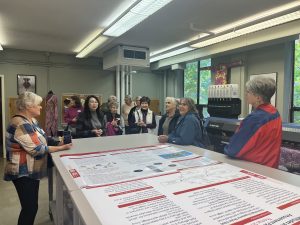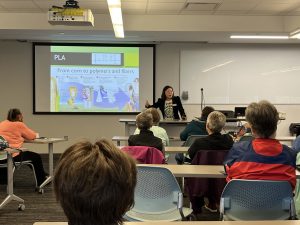Quilters visit campus, learn about textile science

AMES, Iowa – Local quilters had the opportunity to connect with and learn from faculty in Iowa State University’s Department of Apparel, Events, and Hospitality Management. The Ames Quilt Guild and ISU Block Builders brought over 50 members to campus in October and spent a day learning about innovation in textiles.
“Textiles are part of our daily lives,” said Department of Apparel, Events, and Hospitality Management Interim Chair, Linda Niehm. “These groups have a passion for using textiles to create heirloom quilts and we were able to show them how our research is using textiles to design clothing, protect fire fighters, and create a more sustainable future.”
Associate Professor, Chunhui Xiang, and Research Assistant Professor, Rui Li, shared current textiles research topics. They shared information about polylactic acid fiber, a type of biodegradable synthetic fiber made from corn starch and sugar cane. And, they discussed the work happening on campus in the areas of healthcare and firefighter personal protective equipment.
“As a former healthcare worker when personal protective equipment was scarce at the beginning of the pandemic, I personally found the current research, their passion and possibilities in this area truly inspiring,” shared Kelly Dehner, an attendee at the event. “The experience opened my mind to the important research happening at Iowa State, as well as a feeling of hopefulness for future innovations.”
The group had the opportunity to tour the department’s Digital Apparel and Textiles Studio (DATS Lab) and explore the high-tech equipment used in digital textile printing, embroidery and Lasater cutting.
“When we visited the sewing and pattern creation labs, I was impressed to see how students are really pushing their boundaries at creating their own fabrics and garments,” said Lois Carpenter, an attendee at the event.
Guests also learned from researchers in the Lab for Clothing Comfort for Performance where the thermal properties of clothing material are scientifically studied. Paired with human activity (metabolic rate) and environmental conditions (temperature, wind speed, humidity), researchers can predict human comfort and heat stress levels.
In the Lab for Heat and Thermal Protection Research, the group got to see how researchers can use state-of-the-art equipment that mimics actual occupational environments that might occur to first responders, fire fighters, police officers, military personnel and health care workers to test current equipment and design new materials to better protect workers from hazards.
Guests also experienced lunch in the student-operated Joan Bice Underwood Tearoom and were able to tour the Student Innovation Center, spending time in the department’s student-operated store and café.

